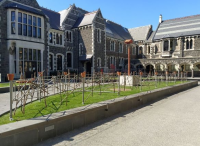
In the North Quad of Te Matatiki Toi Ora, the Arts Centre, on one of the raised grass beds is a multitude of combined memories of a place. This multitude is commonly referred to by a single, reductive word; history. With Return home Tūī. Let your song remind us of histories unseen Martin Awa Clark Langdon acknowledges history and site specificity as more than just an historic building. This work for SCAPE Public Art sits in conversation with the exhibition at The Physics Room’s, Room to breathe: Ka tau hā te mauri, also by Langdon. Both exhibitions stem from the same conceptual base; remembering “Te Araiteuru”, a staged Māori pā created for the 1906-7 New Zealand International Exhibition.
The raised grass bed with scaffolding at its boundary nods to a pā. Letter forms made from kōrari, flax stalks are lashed to the scaffold, drawing shadows of a tangled language. Within the border is a 3D printed replica of a tī kōuka tree, with a section of the original tree at its top, supporting a wharemanu, birdhouse. At its base is a large concrete foundation block, reminiscent of those found assisting the ongoing reconstruction of Te Matatiki Toi Ora.
Common across the three works in The Physics Room exhibition and the work for SCAPE is the creation of space. By demarcating an area and offering a space for contemplation, Langdon suggests an alternative approach to “Te Araiteuru”. The staged pā was for spectacle and entertainment – not a space created for the people it feigned to represent.
The popular vision-oriented metaphor for remembering, “to look back”, doesn’t allow for the sound of a tūī’s call or the feel of a place. “Return home Tūī” refers to a number of Māori proverbs which relate the appearance of kōwhai flowers to the arrival of Spring – with the new season returns the tūī and kai such as whitebait. Time and history are treated by Langdon like an accumulative substance; layering and merging – sticky – inextricable and ongoing. All in one place are new technologies, old technologies, the tūī song, memories of the earthquake, a staged pā, a mahinga kai.
Lashed kōrari appears in both The Physics Room and SCAPE exhibitions. Langdon says that one translation or understanding of hohou, lashing, is ‘to settle,’ and the same verb carries the meaning ‘to make peace.’ The action seems capable of combining objects, histories, peoples and memories, to settle and to rest together. The act of lashing is hard on the hands, it abrades the edges of fingers pulling the twine tight. There is effort, pain and something taught (and taut) involved in lashing, just as there is in the ongoing recognition of histories of a place.
While each work in Room to breath: Ka tau hā te mauri came out of different collaborative relationships, perhaps Return home Tūī offers a collaborative engagement for the audience to consider te whenua and tangata whenua, histories unseen and stories both written and unwritten.
DETAILS
Northern Quad, Arts Centre Te Matatiki Toi Ora, 2 Worcester Boulevard
IMAGE
- Martin Awa Clarke Langdon Return home Tūī, let your song remind us of histories unseen Image courtesy of the artist and SCAPE Public Art.
